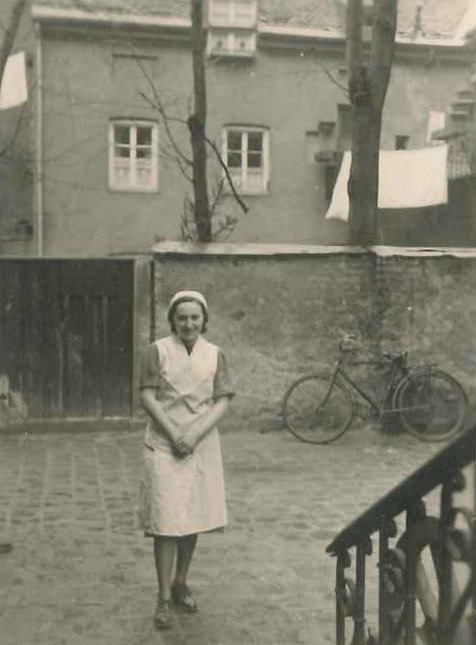Residencies
Augsburg, Völkstraße 33
Last voluntary residence
Places of persecution
Deportation
from Augsburg
via Munich-Milbertshofen
to Piaski
on 2 April 1942
Margot Herrmann was born in Augsburg in 1921 as the older daughter of Josef and Cilli Herrmann. Together with her sister Trude, who was four years younger, (see biography of Trude Herrmann), she grew up at 33 Völkstrasse in the refined upper-middle class Beethoven quarter. Three of her cousins, about the same age, also lived in this neighborhood. Her parents sent Margot to the Catholic primary school St. Elisabeth, where she was instructed by nuns. Grandfather Moses/Moritz Stern, a fabric merchant, had done business with various facilities of the Catholic church. Perhaps this helped establish a good relationship with the convent. Later, Margot also attended middle school at St. Elisabeth. There she made friends with Kunigunde Hutzmann who stayed faithfully at her side, even when the Nazi propaganda declared Jews as “Untermenschen” (subhumans).
Margot was a particularly good student. But like her younger sister and her cousins, she also loved to spend her spare time at the sports field of the Jewish sports club PTGA (Private Tennis Club Augsburg).


The Augsburg Jewish Community had expanded the facility after the public sports clubs excluded their Jewish members, already a few weeks after Adolf Hitler assumed power. On Alter Heuweg, the Jewish youth met, not only for athletic competition; the sports field also was the only retreat for those who were being more and more excluded from public life. They were no longer permitted in movie theaters; from 1935 on they were also banned from public swimming pools; and in the streets, more and more signs were appearing: “Jews not welcome”.1
After graduating from middle school in 1937, Margot registered at a housekeeping school in Frankfurt, together with her friend Lotte Neuburger. She was so homesick, however, that after a short while, she dropped out of that school and returned to Augsburg.2 Since she did not want to part with her parents, in 1939, she also did not take the Kindertransport place her parents had registered her for. Together with her parents and her sister, she waited for the immigration permit to England for the whole family. During this time, Margot and her uncle Justin Stern and his son Manfred, commuted daily to Munich in order to learn a skill for life in a new country.

When, at the outbreak of the war, tenant protection for Jews was lifted, the family was forced to give up its comfortable home on Völkstrasse and to move to 10 Hermanstrasse. They had to wear the yellow star and now lived in complete isolation. The Jewish sports club had ceased to exist and they were no longer allowed to go outside after 8:00 pm. From April 1941 on, Margot, like other Jewish women, had to work as a forced laborer for the armaments industry at the balloon factory. Only her friend Kunigunde still came to visit her. She dared to do this, however, only after nightfall, since the national socialists brandmarked contact with Jews as betrayal of one’s own people. On April 2, 1942, the national socialists deported Margot Herrmann her sister Trude and their parents via the Milbertshofen camp to Piaski in the “Generalgouvernement” (Poland occupied by Germans). None of them survived the camp.
One year earlier, Margot had signed her friend Kunigunde’s poetry album:
“To believe in God / is the beginning of joy;
To worship God / is the growth of joy;
To love God / is the fullness of joy.”3
Benigna Schönhagen (Translation by Michael Bernheim)
- Mitteilung von Henry Stern an die Verfasserin vom 19.12.2018. | Communication of Henry Stern with the author of December 19, 2018. ↩
- Mitteilung von Henry Stern an die Verfasserin vom 5.8.2013 (Jüdisches Kulturmuseum Augsburg-Schwaben, Konvolut Henry Stern). | Communication of Henry Stern with the author of August 5, 2013 (Jüdisches Kulturmuseum Augsburg-Schwaben, Konvolut Henry Stern). ↩
- Benigna Schönhagen, „… und dann heißt’s Abschied nehmen aus Augsburg und Deutschland.“ Der Weg der Familie Stern aus Augsburg. (Lebenslinien. Deutsch-Jüdische Familiengeschichten 06), Augsburg 2013, S.98. ↩
Ein gewisses jüdisches Etwas. Eine Ausstellung zum Selbermachen vom 12. Juni bis 30. August 2009. Dokumentation der Ausstellung, hrsg. von Benigna Schönhagen, Augsburg 2009, S.14.
Benigna Schönhagen, „… und dann heißt’s Abschied nehmen aus Augsburg und Deutschland.“ Der Weg der Familie Stern aus Augsburg. (Lebenslinien. Deutsch-Jüdische Familiengeschichten 06), Augsburg 2013.


